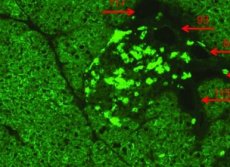Medical expert of the article
New publications
Scientists have filmed the world's first real-time video of the development of type 1 diabetes
Last reviewed: 01.07.2025

All iLive content is medically reviewed or fact checked to ensure as much factual accuracy as possible.
We have strict sourcing guidelines and only link to reputable media sites, academic research institutions and, whenever possible, medically peer reviewed studies. Note that the numbers in parentheses ([1], [2], etc.) are clickable links to these studies.
If you feel that any of our content is inaccurate, out-of-date, or otherwise questionable, please select it and press Ctrl + Enter.

Scientists at the La Jolla Institute of Allergy and Immunology have created the first film that shows the destruction of beta cells in type 1 diabetes in real time.
"We present the first images of the development of type 1 diabetes at the cellular level," said study author Matthias von Herrath. "Being able to see the interactions of insulin-producing cells in the pancreas in real time greatly improves our ability to find effective treatments for type 1 diabetes."
A paper on the team's scientific findings, along with cell films, was published in the journal Clinical Investigation. The films are freely available and can be viewed at www.jci.orghere.
These images provide important information about the disease process, in particular showing the causes of beta cell destruction (which underlies the development of type 1 diabetes).
In the film, you can see objects that resemble ants walking through the forest in search of their victims. The "ants" are actually T cells of the immune system. The "victims" are insulin-producing beta cells, which the T cells mistakenly attack and destroy, which ultimately leads to the development of type 1 diabetes.
The groundbreaking research was carried out using a two-photon microscope using a new technique developed by Dr. von Herrath, which allowed the microscope to be used directly in the pancreas.
The movies do a particularly interesting job of showing how beta cells are destroyed. T cells move randomly throughout the pancreas until they encounter beta cells, where they slow down and release toxic substances that eventually kill the beta cells. What's most amazing is that this "kiss of death" can take a long time.
The scientists also found that massive destruction of pancreatic cells occurs when T-cell numbers reach tens of millions. "These factors may explain the long preclinical stage of type 1 diabetes," said Dr. von Herrath.
"This means that autoimmune attacks occur for many years before the number of beta cells falls below a critical threshold that leads to clinical manifestation of the disease," he said, noting that 90% of beta cells are destroyed in the human body before symptoms of diabetes appear. From a therapeutic standpoint, these studies show that scientists need to find a way to prevent T cell attacks in the pancreas.


 [
[